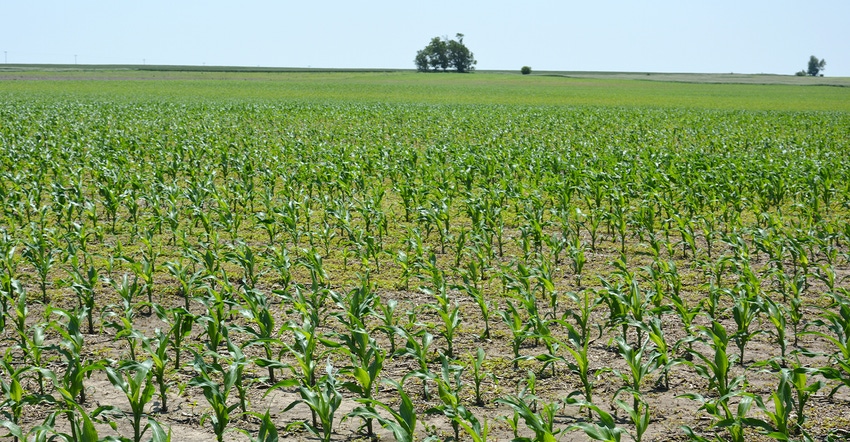January 10, 2020

The land market in 2019 continued the plateau trend of the past several years during which the supply of agricultural land for sale on the market remained lower than average and prices for good quality cropland held mostly steady. Looking ahead to next year, will financial stress from lower commodity prices and poor harvests in some regions cause prices to decline?
Farmland sale activity in the first part of 2019 was slower than it had been for some time with late spring and early summer especially void of farms for sale. Planting delays and prevented plantings contributed to the lackluster activity.
“Despite the slower land market, Farmers National Co. and its agents saw a 25% increase in acres sold in 2019 from the prior year and the most since 2014,” says Randy Dickhut, senior vice president of real estate operations. “Sellers are seeking the best advice and marketing strategy to sell their land and that is why the amount of land listed for sale at Farmers National is very strong at over $300 million.”
Land values in 2019 once again bucked the prevailing depressed mood in agriculture to hold steady or even increase slightly in some instances except for the most stressed areas or segments such as dairy. With generally more cautious buyers, some markets saw a move to private treaty listings or bid sales instead of the traditional public land auction.
“The lower supply of land for sale had much to do with land prices being mostly steady as did having adequate demand for quality cropland,” Dickhut says. “Lower quality farmland had less demand and in many cases was harder to sell. Investor interest in cropland increased somewhat in 2019 with several new entities entering the market and also from an increase in purchasing activity by existing institutional investors.”
Several other factors had a favorable effect on farmland values in 2019. Interest rates remained historically low and moved even lower during the year when at one time, most thought rates would work higher. The other significant factor supporting land values and buyer demand, especially by farmers, was the amount of government support for production agriculture. One third of agriculture's 2019 net farm income came from government provided sources including crop insurance, the Market Facilitation Program, and various other conservation and program funding.
In 2019, the ag industry endured floods, planting frustrations, trade uncertainty and struggling commodity prices. Financial conditions for some producers degenerated, but agriculture overall remains in better shape than expected due to support payments and the fact that land values remain historically strong. The land market weathered many storms in 2019 just like U.S. agriculture as both balanced precipitously on the plateau of the past five years.
So will 2020 be the year that the land market breaks out of its plateau?
“There are a number of factors that indicate that the land market will continue to be steady in 2020,” Dickhut says. “Interest rates are low and are poised to remain so during the foreseeable future and government support through MFP payments will likely continue if Chinese trade issues are not fully resolved. Overall, agriculture is in adequate financial shape, but there are individual and regional concerns.”
There are also factors that could have a more depressing influence on farmland values in 2020, Farmers National reported. In addition to on-going trade disruptions, there is the concern if there will be an increase in financially caused sales of land by producers. Buyer demand for good cropland has been adequate for the supply and this would have to remain so in order for land values to continue on their plateau.
Nebraska, Kansas, Oklahoma and Texas
“Land sale activity across the Southern Plains has been quite varied and dependent on location, quality and use,” says Paul Schadegg, area sales manager for Farmers National. “In general, good quality continues to sell while lower quality land struggles.”
During the fall, Farmers National auctioned a good-quality crop farm in north-central Kansas for $8,800 per acre, which was near record for the area even though land prices are off the peaks by five years.
“Our local agent did a great job talking with all the potential buyers, and Farmers National did a full marketing campaign for the sale. We definitely reached the buyers,” Schadegg says.
Texas timberland and ranches are in demand from buyers and are holding or increasing in price. In Oklahoma, Schadegg says that Farmers National has held a number of “good auctions selling both cropland and grass.”
“Nebraska land buyers are being more cautious, forcing sellers to be more realistic in a price that will consummate a sale,” Schadegg says.
Looking ahead into the coming year, attention turns to what is going to impact the farm economy and the land market and whether or not the current lower commodity prices will be the new normal. Financial stress has increased for some individual farm operators, but overall financial conditions in agriculture are adequate.
With the current land market sitting on a plateau for the past several years, landowners are asking questions about what to do if they are thinking of selling their farm
“We are getting sellers calling Farmers National looking for good advice about the land market and for the best marketing and sales strategy to get their land sold. These landowners want someone they can trust to sell their farm,” Schadegg says.
Farmers National, an employee-owned company, is the nation’s leading agricultural landowner services company. The company has sold 3,878 properties and more than $5 billion of real estate during the last ten years. For more information, visit the Farmers National website.
Source: Farmers National Co., which is solely responsible for the information provided and is wholly owned by the source. Informa Business Media and all its subsidiaries are not responsible for any of the content contained in this information asset.
You May Also Like




